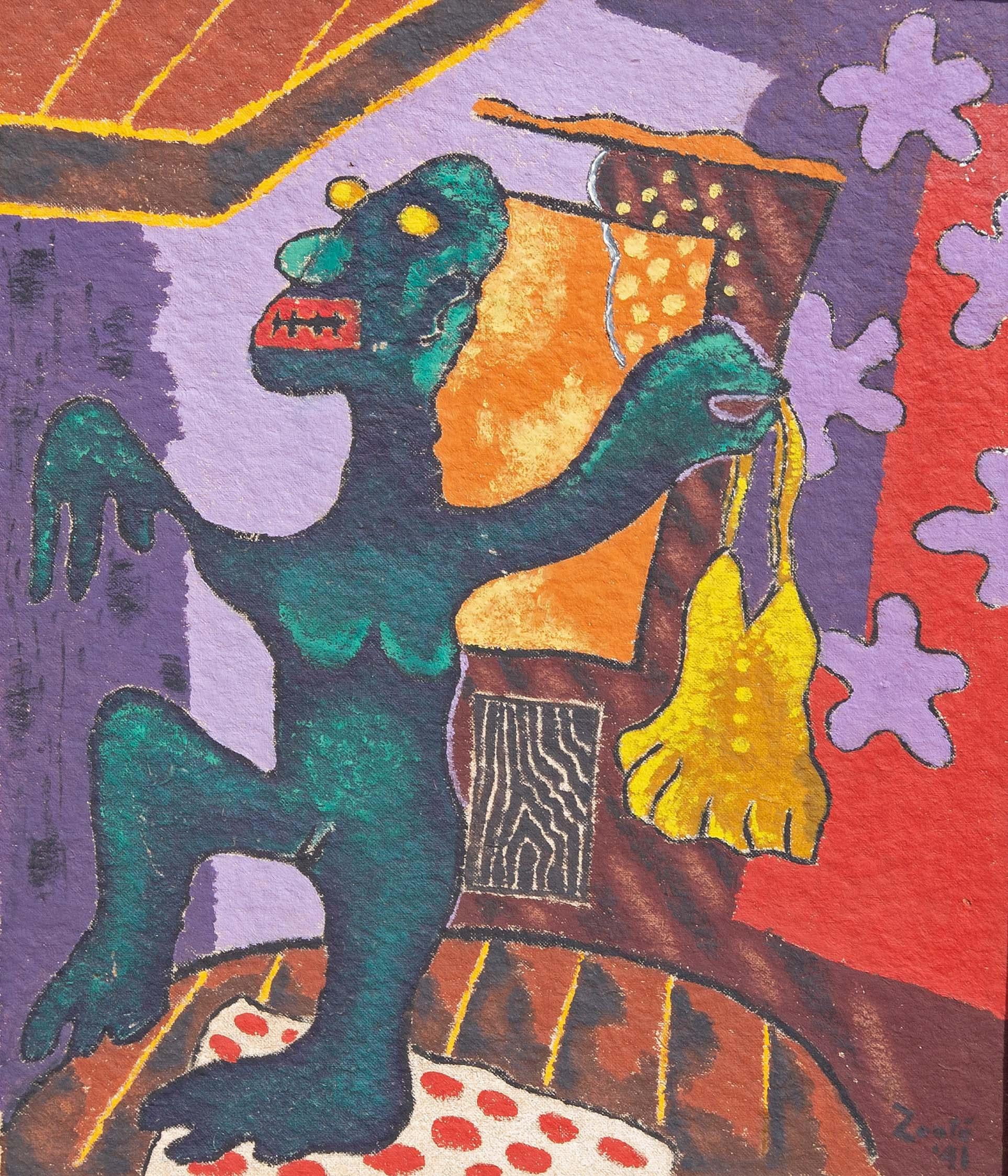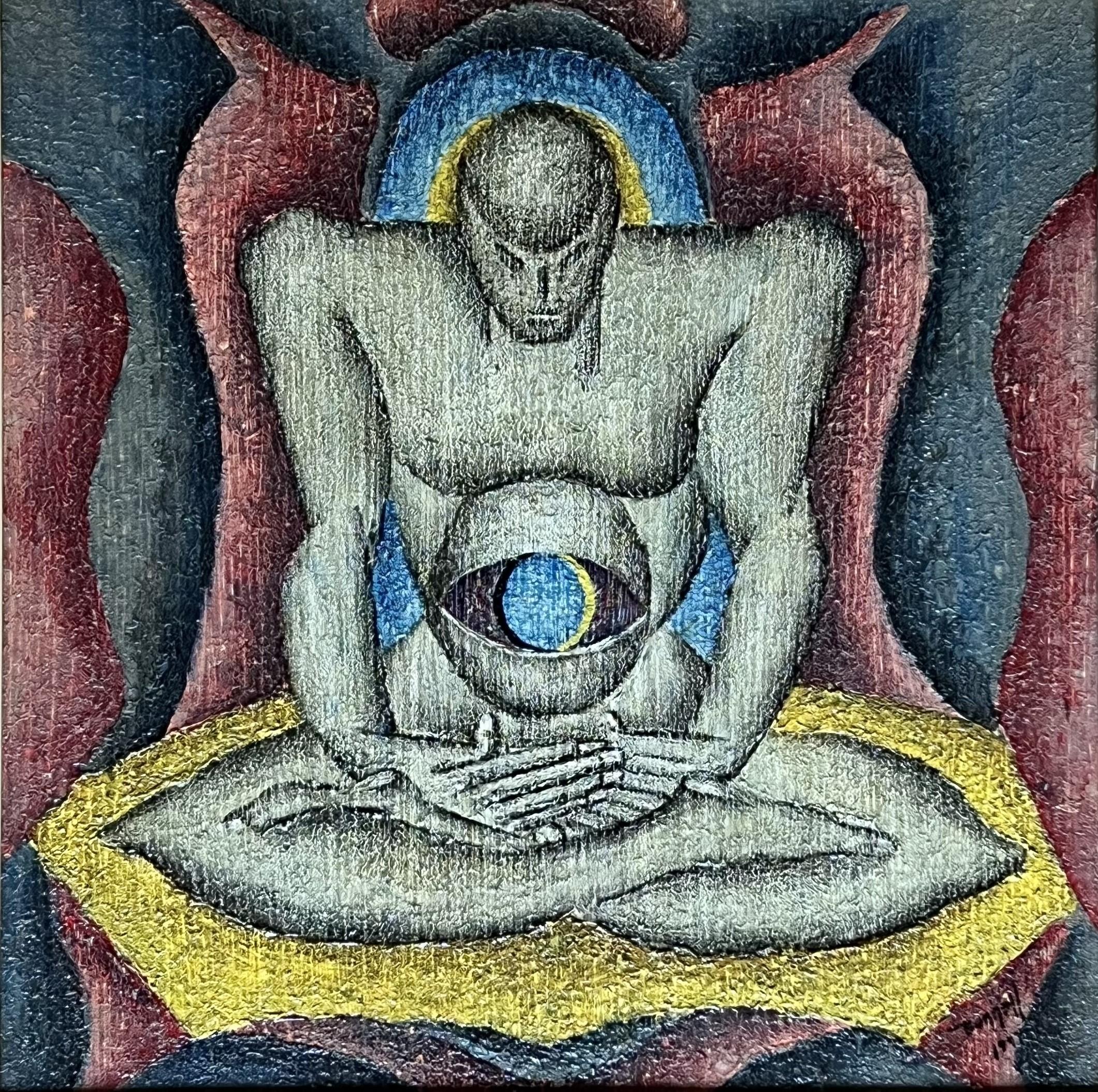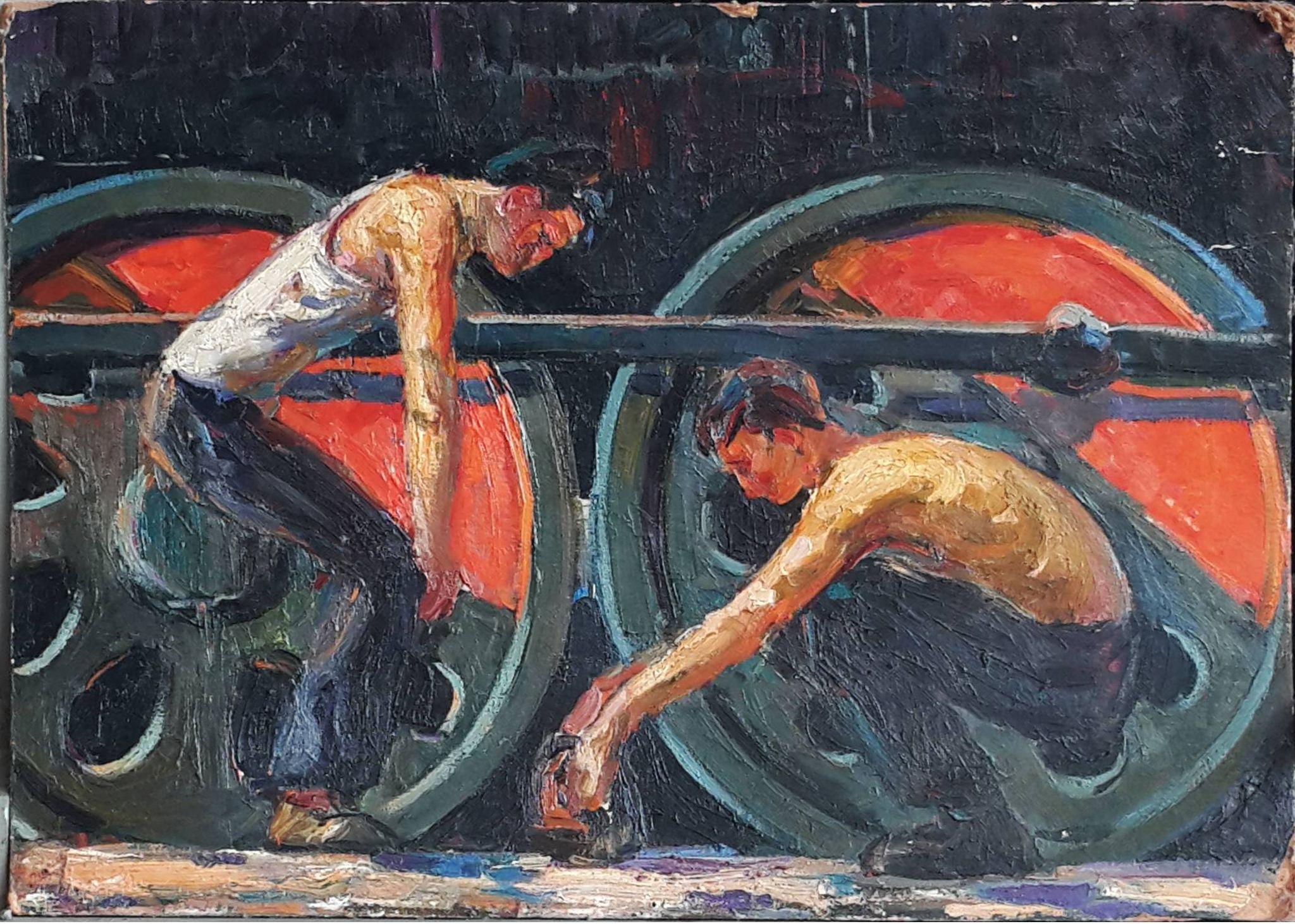Items Similar to Modernist Rabbi at Study Judaica Oil Painting
Want more images or videos?
Request additional images or videos from the seller
1 of 6
Ben-ZionModernist Rabbi at Study Judaica Oil Painting
About the Item
Genre: Judaica
Subject: Religious
Medium: Oil
Surface: Board
Country: United States
Dimensions: 17.5" x 21.75"
Dimensions w/Frame: 24" x 28"
Born in 1897, Ben-Zion Weinman celebrated his European Jewish heritage in his visual works as a sculptor, painter, and printmaker. Influenced by Spinoza, Knut Hamsun, and Wladyslaw Reymont, as well as Hebrew literature, Ben-Zion wrote poetry and essays that, like his visual work, attempt to reveal the deep “connection between man and the divine, and between man and earth.”
An emigrant from the Ukraine, he came to the US in 1920. He wrote fairy tales and Judaic poems in Hebrew under the name Benzion Weinman, but when he began painting he dropped his last name and hyphenated his first, saying an artist needed only one name.
Ben-Zion was a founding member of “The Ten: An Independent Group” The Ten” a 1930’s avant-garde group, Painted on anything handy. Ben-Zion often used cabinet doors (panels) in his work. Other members of group included Ilya Bolotowsky, Lee Gatch, Adolf Gottlieb, Louis Harris, Yanhkel Kufeld, Marcus Rothkowitz (later known as Mark Rothko), Louis Schanker, and Joseph Solman. The Art of “The Ten” was generally described as expressionist, as this style offered the best link between modernism and social art. Their exhibition at the Mercury Gallery in New York held at the same time as the Whitney Annual Exhibition of Contemporary American Painting, included a manifesto concentrating on aesthetic questions and criticisms of the conservative definition of modern art imposed by the Whitney. Ben-Zion’s work was quickly noticed. The New York Sun said he painted “furiously” and called him “the farthest along of the lot.” And the triptych, “The Glory of War,” was described by Art News as “resounding.”
By 1939, The Ten disbanded because most of the members found individual galleries to represent their work. Ben-Zion had his first one-man show at the Artist’s Gallery in Greenwich Village and J.B. Neumann, the highly esteemed European art dealer who introduced Paul Klee, (among others) to America, purchased several of Ben-Zion’s drawings. Curt Valentin, another well-known dealer, exhibited groups of his drawings and undertook the printing of four portfolios of etchings, each composed of Ben-Zion’s biblical themes.
Ben-Zion’s work is represented in many museums throughout the country including the Metropolitan, the Whitney, and the Museum of Modern Art in New York, the Art Institute of Chicago, the Philadelphia Museum of Art and the Phillips Collection, Washington. The Jewish Museum in New York opened in 1948 with a Ben-Zion exhibition.
“Ben-Zion has his hands on the pulse of the common man and his natural world”
As he emerged as an artist Ben-Zion never lost his gift for presenting the ordinary in ways that are vital, fresh and filled with emotions that are somber and exhilarating, joyous and thoughtful, and ultimately, filled with extraordinary poetic simplicity.
Ben-Zion consistently threaded certain subject matter—nature, still life, the human figure, the Hebrew Bible, and the Jewish people—into his work throughout his life. "In all his work a profound human feeling remains. Sea and sky, even sheaves of wheat acquire a monolithic beauty and simplicity which delineates the transient as a reflection of the eternal. This sensitive inter- mingling of the physical and metaphysical is one of the most enduring features of Ben-Zion's works." (Excerpt from Stephen Kayser, “Biblical Paintings,” The Jewish Museum Catalogue, 1952).
Ben-Zion continued his style of representational painting based on the abstract, and is perhaps best known for his Biblical paintings and etchings.
Ben-Zion received an American Jewish Congress award.
In 1987, Ben-Zion died in his home in the Chelsea section of Manhattan. He was 90 years old.
- Creator:Ben-Zion (1897-1987, American)
- Dimensions:Height: 24 in (60.96 cm)Width: 28 in (71.12 cm)
- Medium:
- Movement & Style:
- Period:
- Condition:frame has wear, painting has wear commensurate with age and use. Please see photos.
- Gallery Location:Surfside, FL
- Reference Number:1stDibs: LU38211989182
About the Seller
4.9
Platinum Seller
These expertly vetted sellers are 1stDibs' most experienced sellers and are rated highest by our customers.
Established in 1995
1stDibs seller since 2014
1,550 sales on 1stDibs
Typical response time: 1 hour
- ShippingRetrieving quote...Ships From: Surfside, FL
- Return PolicyA return for this item may be initiated within 3 days of delivery.
More From This SellerView All
- 1950s Academic Realistic Study of Hands Oil Painting Signed Stuart WhyteLocated in Surfside, FL1950s Academic Realistic Study of Hands Oil Painting Signed Stuart Whyte In the manner of Auguste Rodin.Category
1950s Modern Figurative Paintings
MaterialsOil, Board
- Large Modernist Oil Painting 1940s, Judaica Hasidic Shtetl Wagon Driver WPA EraBy Emanuel Glicenstein RomanoLocated in Surfside, FLGenre: Modern Subject: Landscape with figure of horse, driver and wagon Medium: Oil Surface: wood Board EMANUEL ROMANO Rome, Italy, b. 1897, d. 1984 Emanuel Glicen Romano was born in Rome, September 23, 1897. His father Henryk Glicenstein was a sculptor and was living in Rome with his wife Helena (born Hirszenberg) when Emanuel was born. His father obtained Italian citizenship and adopted the name Enrico. Emanuel was brought up in Italy, Switzerland, Germany, England and Poland. In 1926 Emanuel Glicenstein Romano and his father sailed for New York. They briefly visited Chicago. Romano's sister, Beatrice, and mother only joined them in New York years later. Romano changed his name on his arrival to America and some have erroneously speculated that this was to avoid antisemitic discrimination. In truth, as the son of a highly-regarded artist, Romano changed his name to ensure that any success or recognition he would later attain, would be the result of nothing other than his own merit as an artist, and not on account of his father's fame. In 1936 Romano was worked for the WPA Federal Art Project creating murals. ( there were many jewish artists active with in the WPA period. notably Chaim Gross, Ben Shahn, Isaac and Moses Soyer, Abraham Rattner and many others. During and immediately after World War II, Romano created a series of allegorical works depicting graphic holocaust images that were held closely by the family until after his passing. One of these works is now on permanent display in the Florida Holocaust Museum in St. Petersburg Florida. Emanuel's father died in 1942 in a car accident before they could realize their shared dream of visiting Israel. In 1944 Romano, having completed his degree at the Pennsylvania Academy of Fine Arts and the Art Institute of Chicago, began teaching at the City College of New York. Romano moved to Safed, Israel in 1953 and established an art museum in his father's memory, the Glicenstein Museum. COLLECTIONS Indianapolis Museum of Art Metropolitan Museum of Art Boston Fine Arts Museum Fogg Museum Musée Nacional de France Recently his work has been added to the Florida Holocaust Museum collection. His notable works include his holocaust themed allegorical paintings as well as portraits of Marianne Moore, his father and William Carlos Williams...Category
1930s American Modern Figurative Paintings
MaterialsOil, Board
- Judaica Oil Painting Jewish Family Interior Shtetl SceneBy Peter HorowitzLocated in Surfside, FLPeter Horowitz, painter, born 1922, Poland. Lived in Hod Hasharon in Israel. Studied at the Art Academy, Krakow. died in 2005. Studies: Art Academy, Cracow. Peter Horowitz was born...Category
Mid-20th Century Modern Figurative Paintings
MaterialsOil, Board
- The Preacher Rabbi "Der Maggid" Judaica Oil Painting WPA Jewish artistBy Maurice KishLocated in Surfside, FLGenre: Modern Subject: Hasidic Rabbi preaching in Synagogue Medium: Oil Surface: Board, size includes artist decorated frame Country: United States The imagery of Maurice Kish (189...Category
Mid-20th Century Modern Figurative Paintings
MaterialsOil, Board
- Modernist Oil Painting 1940s, Judaica Hasidic Rabbi in JerusalemBy Emanuel Glicenstein RomanoLocated in Surfside, FLGenre: Portrait Subject: Landscape Medium: Oil Surface: Board Country: United States EMANUEL ROMANO Rome, Italy, b. 1897, d. 1984 Emanuel Glicenstein Romano was born in Rome, September 23, 1897. His father Henryk Glicenstein was a sculptor and was living in Rome with his wife Helena (born Hirszenberg) when Emanuel was born. His father obtained Italian citizenship and adopted the name Enrico. Emanuel was brought up in Italy, Switzerland, Germany, England and Poland. In 1926 Emanuel and his father sailed for New York. They briefly visited Chicago. Romano's sister, Beatrice, and mother only joined them in New York years later. Romano changed his name on his arrival to America and some have erroneously speculated that this was to avoid antisemitic discrimination. In truth, as the son of a highly-regarded artist, Romano changed his name to ensure that any success or recognition he would later attain, would be the result of nothing other than his own merit as an artist, and not on account of his father's fame. In 1936 Romano was worked for the Federal Art Project creating murals. During and immediately after World War II, Romano created a series of allegorical works depicting graphic holocaust images that were held closely by the family until after his passing. One of these works is now on permanent display in the Florida Holocaust Museum in St. Petersburg Florida. Emanuel's father died in 1942 in a car accident before they could realize their shared dream of visiting Israel. In 1944 Romano, having completed his degree at the Pennsylvania Academy of Fine Arts and the Art Institute of Chicago, began teaching at the City College of New York. Romano moved to Safed, Israel in 1953 and established an art museum in his father's memory, the Glicentein Museum. COLLECTIONS Indianapolis Museum of Art Metropolitan Museum of Art Boston Fine Arts Museum Fogg Museum Musée Nacional de France Recently his work has been added to the Florida Holocaust Museum collection. His notable works include his holocaust themed allegorical paintings as well as portraits of Marianne Moore, his father and William Carlos Williams...Category
1970s American Modern Figurative Paintings
MaterialsOil, Board
- Modernist Judaica Oil Painting "Old Jew" Jewish Rabbi at PrayerBy Ben-Zion WeinmanLocated in Surfside, FLAn oil on board Judaic painting by modern artist Ben-Zion Weinman. It depicts a portrait in profile of an old Jew. The work is signed "Ben-Zion". Born in 1897, Ben-Zion Weinman celebrated his European Jewish heritage in his visual works as a sculptor, painter, and printmaker. Influenced by Spinoza, Knut Hamsun, and Wladyslaw Reymont, as well as Hebrew literature, Ben-Zion wrote poetry and essays that, like his visual work, attempt to reveal the deep “connection between man and the divine, and between man and earth.” An emigrant from the Ukraine, he came to the US in 1920. He wrote fairy tales and poems in Hebrew under the name Benzion Weinman, but when he began painting he dropped his last name and hyphenated his first, saying an artist needed only one name. Ben-Zion was a founding member of “The Ten: An Independent Group” The Ten” a 1930’s avant...Category
1940s American Modern Figurative Paintings
MaterialsOil, Board
You May Also Like
- Abstract American Modernist Oil Painting "My Dancing Shoes" by Zoute 1941Located in Rochester, NYAbstract Modernist oil painting by Zoute dated 1941. Oil on board. Unframed. Zoute (Born-Leon Salter, 1903-1976) was self-taught and well exhibited during his lifetime. He painted from 1940-1954 (he stopped painting at this later date due to his wife's illness and death and never painted again) A self-taught artist, he was part of the great modern wave. He exhibited with many of the most notable artists of the day such as Picasso, Braque, Klee and others at the invitation only State University of Iowa International Show 1946-1947. He had numerous one man shows at NYC galleries, Mortimer Levitt / Joseph Heller...Category
Mid-20th Century Modern Figurative Paintings
MaterialsOil, Board
- Untitled (Transcendental Composition)By Charles Ragland BunnellLocated in Los Angeles, CAThis work is part of our exhibition - America Coast to Coast: Artists of the 1940s Untitled (Transcendental Composition), oil on board, 1947, oil on board, signed and dated lower r...Category
1940s American Modern Paintings
MaterialsOil, Board
- Modern Georgian Art by Grigol Chirinashvili - HarvestLocated in Paris, IDFOil on cardboardCategory
2010s Modern Figurative Paintings
MaterialsOil, Cardboard
- Modern Georgian Art by Grigol Chirinashvili - Depo WorkersLocated in Paris, IDFOil on cardboardCategory
2010s Modern Figurative Paintings
MaterialsOil, Cardboard
- Modern Georgian Art by Grigol Chirinashvili - Autumn in Kakheti, GeorgiaLocated in Paris, IDFOil on cardboardCategory
2010s Modern Figurative Paintings
MaterialsOil, Cardboard
- Modern Georgian Art by Grigol Chirinashvili - The LandscapeLocated in Paris, IDFOil on cardboardCategory
2010s Modern Figurative Paintings
MaterialsOil, Cardboard
Recently Viewed
View AllMore Ways To Browse
Oil Paintings Modernist
World War Oil Painting
Modernist Oil Paint
Oil Paintings Philadelphia
Old Vintage Oil Painting Paintings
European Modernist Art
Oil Paintings 1952
1920s Style Paintings
Aesthetic Vintage Painting
Aesthetic Vintage Paintings
Aesthetic Painting Vintage
Vintage Sun Painting
Modern Jewish Painting
90s Painting
Ten Works Ten Painters
Oil Paintings Of Doors
Aesthetic Paintings Retro
Oil Painting With Door





